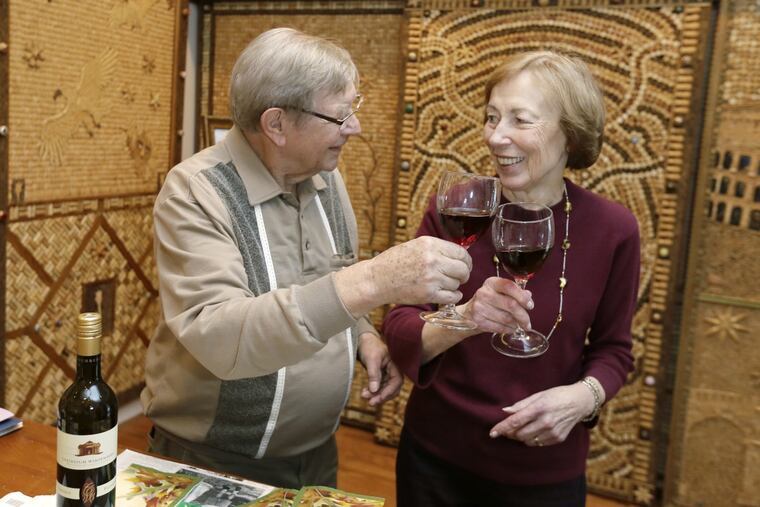Cork art finds a higher calling
Walter Deuschle, 88, wields a 10-inch butcher knife with the steady hands of the master chef he was for decades, slicing and shaving a wine cork into hundreds of tiny pieces, each with a purpose in his precise mind.

Walter Deuschle, 88, wields a 10-inch butcher knife with the steady hands of the master chef he was for decades, slicing and shaving a wine cork into hundreds of tiny pieces, each with a purpose in his precise mind.
Behind him in his Huntingdon Valley studio is what at first appears to be a wall of floor-to-ceiling stained glass windows in luminous reds, blues, greens, and yellows: one of the Annunciation, one of St. Peter watching over a woman kneeling in prayer while another stoops to harvest grain, and one of angels with butterfly wings ascending to heaven on musical notes.
But the light in these spiritual images is not filtering through stained glass. Instead, it is the illusion of light that Deuschle created by surgically carving between 1,500 and 2,000 natural and plastic wine corks in his self-made miter box, then painstakingly gluing them together with Elmer's glue to craft his religious visions.
Those visions often come to him in the middle of the night, Deuschle said, awakening him from a deep sleep and propelling him into his studio to sketch them before they vanish.
"It's a scary thing," he said. "I have a lot of moments during the night when I see what I want to do. I know how to do it, but I don't know how it will turn out. As they say in French, une étape à la fois - one step at a time."
After drawing a biblical scene on a four-by-seven-foot sheet of plywood, Deuschle works from the outside in, building the background with natural corks, then creating the religious figures with pastel-colored synthetic corks.
Deuschle, who came to Pennsylvania in 1956 from Stuttgart in his native Germany, was a chef and a country club manager before retiring 23 years ago and accidentally discovering wine corks as his artistic medium.
He had collected some for the local Boy Scouts, who were using them to make trivets for Mother's Day. But "all of a sudden, about 12 years ago, the Boy Scouts stopped making trivets," Deuschle said. "I had a couple hundred corks in my garage, and my friends kept giving me more. Soon, I had 4,000.
"I started to make pictures. I don't know why. It just happened. I kept on going. It became part of me. And, poof! Here we are."
He spends four to five months on a project, which he sells for $2,500 to $3,500, but only to a buyer who feels as strongly about his work as he does.
Deuschle doesn't talk in religious terms about his wee-hours visions and cork creations.
"I am not a fanatic," he said of his spirituality. "I'm a down-to-earth thinker. I'm a nature boy."
He said he is inspired by walking in the woods on his property, often stopping at a bench he installed along the path to sit in silence, absorbed in the beauty around him.
Hearing this, his wife, Mary, smiled. "He's a dreamer," she said. "The religious side of him has always been there. His art is a way to share it with other people."
Even in one of Deuschle's secular all-cork sculptures - an ancient-Greek-style museum as big as a supersize doll house, with a grand outdoor staircase and entrance pillars, and tiny chandeliers and rugs inside - are religious paintings that are miniatures of his life-size Christian panels.
Deuschle's favorite panel, a Madonna and Child, has been installed for more than a year in the chapel of nearby Gloria Dei Church.
"The meticulousness that goes into one of these pieces of art is absolutely phenomenal," said the Rev. Jim Goodyear. He noted "a movement of wind blowing through the almost lifelike figures, which I think depicts the Holy Spirit moving through them."
The wind isn't visible, but is a presence the pastor feels in Deuschle's cork art.
"I think Walter is aware that his ability to do what he does comes from a higher being," said Goodyear. "But he doesn't have to go through a lot of ritual type stuff for him to find his closeness to God."
Deuschle expresses his love of God every day when he sits down at his workbench, reaches into his cache of corks, and begins cutting, the clergyman said.
"I think Walter is one of the few people of his generation who understands what the church is moving toward today: We experience the presence of God in everyday life, in everything we do."
267-443-2540@DanGeringer